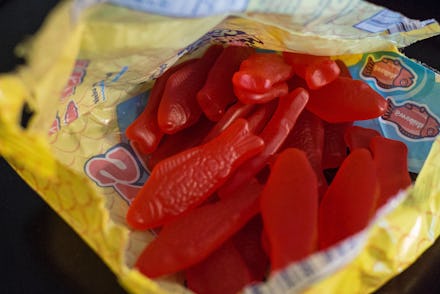Are Swedish Fish really Swedish? Let's trace their origin together, shall we?

"Wait, are Swedish Fish actually Swedish?"
That's the question I asked a Swedish co-worker whom I had just forced to try the new Oreo flavor inspired by the red gummy candy. He looked at me puzzled, probably by both the taste of the cookie and my question.
"Pretty sure it's an American thing," he said. "The only place we can find Swedish Fish in Stockholm is at the American candy store."
It seemed plausible: America has a tendency to create dishes but name them after other countries, after all. German Chocolate Cake, which is not from Germany, and English muffins, which are not from England, are both American inventions, according to Smithsonian.
The Swedish Fish official website happens to be terrifically useless in answering in the question. For a brand that has a country in its moniker, the site is absurdly vague about the candy's origin story. All it really offered up was that "Swedish Fish have been around for a long time." Cool, great, very helpful.
With a bit more searching, I found information that supports the brand's claim about being around for a "long time." The candy was first sold in the U.S. in the 1950s, according to Mental Floss. And ... drumroll please, they were, in fact, invented in Sweden.
Malaco, a Swedish candy company, wanted to expand its business into North America, Mental Floss noted. The company is known for its wine gums, which are a gummy candy made with no gelatin (and not wine) so they are stickier than gummy bears, Smithsonian said.
The Swedish candy company created the fish shape specifically for the American markets as way to create a distinctive look, Mental Floss added. And what better way than to pay homage to Sweden's fishing industry? The candy was an immediate hit in North America.
In 2009, Cadbury Adams, the owner of Swedish Fish at the time, told Mental Floss that it produces 7,000 metric tons (or well over 15 million pounds) of the candy each year. The candy is now owned by Mondelez International, the same company that produces Oreos.
Malaco also sells a version of the fish-shaped candy in Sweden, Mental Floss wrote. There, however, people call them "pastellfiskar," according to Artificial Swedeners. Pastellfiskar translates to "pastel" or "pale" fish. And unlike the version in the U.S., the fish don't have the word Swedish branded into its side. Plus, they come in flavors like salmiak, a salty black licorice flavor that is very popular in Sweden.
So for everyone who just wants to go eat a bag of Swedish Fish instead of reading this, the answer to the question "Are Swedish Fish actually Swedish?" is: Sort of. They were invented by a Swedish company for Americans, but there is now a different version of them sold in Sweden under a different name. Confusing? Somewhat. Delicious? Always.